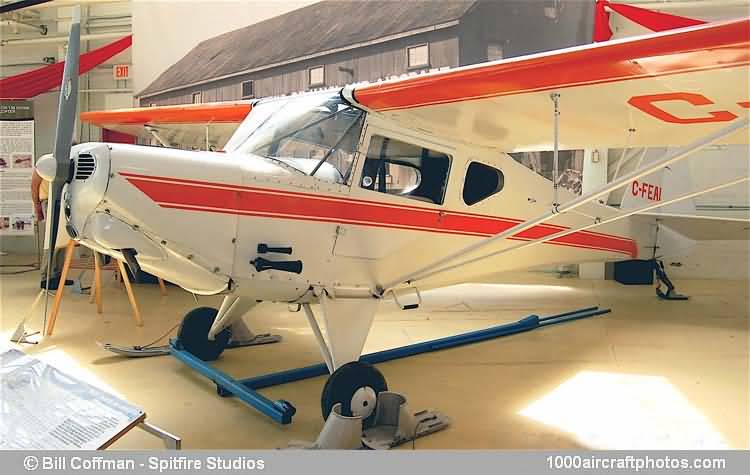11/30/2009. Remarks by Johan Visschedijk: "The origins of this type can be traced back to the Noury designs. The Noury N-75 prototype and the design rights were bought by Fleet Aircraft of Fort Erie, Ontario, Canada in spring 1945.
It was first flown at Fort Erie, by Fleet's Test Pilot T.F. Williams on June 4, 1945, and test flying continued until July 26, when the prototype was put in the shop for alterations. They included a new fin and rudder and the installation of a Continental C85 engine which became the standard power plant. Fleet's Chief Engineer, George E. Otter, responsible for the alterations, had also done the original stressing for Noury. The prototype's first flight after alteration was on September 26, with Williams at the controls.
The new aircraft was designated Model 80 and named Canuck by Walter N. Deisher, Fleet's Vice-President and General Manager, after the Curtiss JN-4 (Canadian) he flew at Ottawa after the first war. The aircraft seated two side-by-side and had a generous baggage allowance of 104 lb (48 kg). Stick control was provided and longitudinal trim was by an elevator tab controlled by a handle on the cabin roof, and wheel brakes and a steerable tail wheel were standard equipment. The 85 hp Continental engine had fuel injection-a popular feature.
The fuselage was constructed of welded steel-tube and was fabric covered. The wing of the Noury-built prototype had wooden spars but all production machines had extruded duralumin spars and sheet duralumin ribs and were fabric covered. Fabric attachment was by the Fleet patented sheet-metal screws rather than the usual rib stitching.
A single three-seat Canuck was made, CF-FAL (c/n X-238), in which the third person could be seated on a jump se at in the baggage compartment. This was designated Model 81 and the construction number had an X prefix.
Fleet developed seaplane floats for the Canuck and they were first tried on June 12, 1946, on CF-DEE (c/n 016), which was fitted with a ventral fin, but it was found to be unnecessary. This first float design was unsatisfactory and only 14 were made. In December 1946 comparative tests were made between CF-DEE fitted with Fleet floats and CF-DPY, (c/n 051), fitted with Short floats (presumably from a Moth).
In March 1947 a float development program was undertaken by altering the contours of a set of Fleet floats fitted to CF-DPY, by fitting wooden boards to the float bottoms and altering the contours as required. This resulted in a float design which gave satisfactory results in service, and had the unusual feature of utilizing the land landing gear for the front mounting.
The Canuck proved popular and sold readily to flying clubs, charter companies and private owners in Canada, and in addition 24 were exported, 19 to Argentina, three to Brazil and one each to Portugal and the United States. However, Fleet had overestimated the market and ran into financial problems. The company was reorganized as Fleet Aircraft & Manufacturing Ltd. and then decided to stop the Canuck production. The design and all remaining components were sold to Leavens Bros of Toronto.
Leavens built a further 25 aircraft and supplied a fuselage which was assembled as a 26th. Early aircraft produced by Leavens were largely an assembly operation of Fleet-built components but later aircraft required more and more manufacturing operations as the stock of Fleet-built parts was used up. Finally, the remaining parts and drawings were sold to Marcel Dorion Aviation of Montreal, which intended to develop the design into a four-seater, but this came not to fruition. In all 224 Canuck aircraft were produced.
Co-owner of this website, Ron Dupas, learned to fly and soloed in a Fleet Canuck in the early 1960s."
